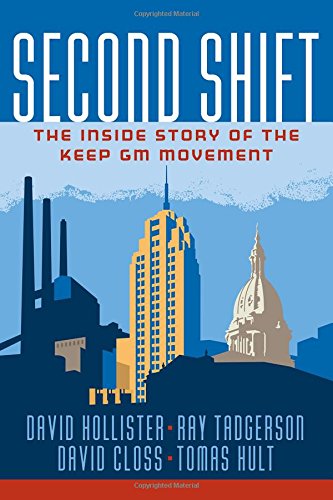 About 20 years ago, General Motors announced it would leave its production facility in Lansing, Michigan. The mayor at that time, David Hollister, refused to accept that and helped lead the fight to keep GM in the city and save jobs. The process, which involved local and state government, community leaders, schools, businesses and many others, was a success. Hollister has collaborated on a new book detailing what happened — Second Shift: The Inside Story of the Keep GM Movement — and he spoke with Knowledge at Wharton about it on the Knowledge at Wharton show on SiriusXM channel 111. (Listen to the podcast at the top of this page.)
About 20 years ago, General Motors announced it would leave its production facility in Lansing, Michigan. The mayor at that time, David Hollister, refused to accept that and helped lead the fight to keep GM in the city and save jobs. The process, which involved local and state government, community leaders, schools, businesses and many others, was a success. Hollister has collaborated on a new book detailing what happened — Second Shift: The Inside Story of the Keep GM Movement — and he spoke with Knowledge at Wharton about it on the Knowledge at Wharton show on SiriusXM channel 111. (Listen to the podcast at the top of this page.)
An edited transcript of the conversation appears below.
Knowledge at Wharton: Let’s go back in time to 1995-1996. Why did GM want to leave Lansing?
David Hollister: Well, I’m not sure they wanted to, but they were downsizing across the country. Between 1995 and 2005, they closed 40 plants. They were under enormous pressure from foreign imports, environmental regulations, higher mileage standards. They were producing a small car in Lansing that was being marketed primarily because it would help them meet the fuel efficiency standards, but they were losing $1,000 on every car they sold. It was a loss leader to meet the federal standards.
In Lansing, you had plants that were 100 years old. Some of the floors were still wooden. There were a lot of reasons to close, and they just kind of said, “Well, let’s close them.” What they didn’t realize is our history of 100 years of great labor management relations. We had a very entrepreneurial labor leadership in the community. And this was not just a normal workforce, this was an extraordinary asset.
I set about the task of putting together a strategy to educate General Motors about the value of the business case for Lansing. But it was also to educate the community on, “we can’t take these people for granted. They’ve been here 100 years, but they could be gone in a minute.” Flint is a nearby community. They went from 50,000 UAW workers to 5,000 and that just devastated that community. That’s what General Motors was facing, and we took the challenge on and turned it around.
“There’s more technology in the car today than there was on the first Apollo moon mission.”
Knowledge at Wharton: This had to involve almost every facet of the local and state government, correct?
Hollister: Yes, and we had no history of working together. In fact, the history traditionally was competition and turf and political battles and divisions. The townships would be competing against the city and the county if there was an opportunity to bring a new business in. They were competing with other people in the region. General Motors was just not going to deal with that kind of a fragmented approach. When I looked at the problem, I had been in the legislature 20 years, and I had no idea that we had 130 different taxing units in our tri-county area. General Motors wanted to deal with one. They are not going to deal with all these folks going after each other.
Our challenge was to put together a united, inclusive, diverse, transparent problem-solving group that could partner with General Motors in tackling the issues that they were facing, whether they were odor issues dealing with the environmental standards or state law. If General Motors was going to build a new plant, they were going to build it for fewer workers. Yet our tax laws, our tax incentive package, only applied if you added new workers on top. Here we were going to be looking at attracting General Motors, if they were going to invest in Lansing, and they were going to have fewer workers. So how do you go to the legislature and tell them you want to change the law when you’re going to have fewer workers at the biggest corporation in America?
Knowledge at Wharton: Tell us about the model you put together, which you called Second Shift.
Hollister: General Motors said that they were going to celebrate the 100th birthday of Oldsmobile by having a weeklong celebration. There were going to be thousands of people coming to Lansing from all over the country. They would have Oldsmobiles from every year in a big parade. There would be just a massive turnout. They were going to be building a new car called the Alero as part of the celebration. It would be made in Lansing. We thought that was pretty good news. But they also told us that they were going to be closing the plants after that because they had no product.
The local plant manager said, “We could build and launch this new car on the second shift.” Traditionally, when you launch a new car, you do it on the first shift. This is the morning shift, where the engineers and the managers and the executives and the senior UAW workers are on the first shift. They’re the old foxes of the workforce. But the plant manager said, “Let’s do it on the second shift,” which is really your bench. It’s your intermediate up and comers. “And send the message to Detroit that we have enough confidence in this workforce that we can launch it on the second shift.” And that’s what we did.
Knowledge at Wharton: Is it fair to say that this plan really did save Lansing?
Hollister: Absolutely. The neighboring community, Flint, is just 50 miles east, and they did close Buick City. They took out 45,000 UAW workers, and that town has never recovered. So this very much was a life-saving ingredient, but it also led to other developments.
For example, one of the co-conveners of our Blue Ribbon Committee that we created was the president of Michigan State University, Peter McPherson. He used this model that we created to go after the Facility For Rare Isotope Beams, which is a federal Department of Energy initiative that was an $800 million project. It was going to be one of the state-of-the-art research facilities in the world. He used that same model of inclusiveness, problem solving, building on your strength, win/win, diversity — these are all components of what we were doing — and brought that to the region. Now our region is second only to Hartford, Connecticut, in finance and insurance. We have a vibrant information technology community with 350 IT companies that have developed in the last 10 years.
Knowledge at Wharton: Part of this also had to be General Motors choosing to work with you to keep the plant open.
Hollister: Initially they said no. They actually told me that they didn’t want a public process, they didn’t want us messing around in their business. We just had to convince them and create a business case that this workforce was so skilled and we had such unique DNA in our region that we could set aside all these turf issues, we could set aside all of these problems and become a one-stop problem-solving group for General Motors. They didn’t believe it initially.
“The whole industry is undergoing a rebirth and a redefinition of who they are.”
As part of our strategy, we hired an engineer who was very up on technology, looked at the internet, looked at what they were doing around the world, saw that they had built a plant in Brazil on 70 acres. And General Motors was advertising that they were going to build a facility somewhere in America, but not in Lansing. We showed them that we could build that plant on 70 acres in the city. We became kind of a problem-solving group for them and partners in solving the older challenges and the changing of the state law.
It started out to be an adversarial circumstance, where General Motors was just seeing the community reacting like any other community. But we actually made a business case involving the local labor people, the neighborhood groups, the state legislators, the governor, who was conservative Republican. I was a liberal Democrat coming out of the legislature. We set those differences aside and were able to focus on solving the problems that were coming at us and became proactive partners instead of just wringing our hands and complaining and criticizing General Motors for leaving.
Knowledge at Wharton: In stories like this, there’s a signature moment where you turn the corner. Was that the case with your story?
Hollister: Yes. I think the decision to go on the second shift really sent an important signal to General Motors and to our workforce. It really created kind of a mystique about it, that this is a high-risk strategy. There were cynics who said we could never pull this off. General Motors had never announced a closing and then reversed itself, in its history. They had closed 40 plants around the country. They had given us the signal that, within five years, we had no product. They told us they didn’t want any public debate about it and didn’t want it to be a public issue. They were going to quietly phase out.
We just turned that around. But it took a very disciplined, proactive, inclusive, transparent, engaged strategy that all elements of the community felt like they had a say, and convinced General Motors to make this investment. Now, they were negotiating with UAW on a national contract. They couldn’t commit to building the plant, even though we had agreed on a plan. We just went on a handshake that we could pull this off and began doing some infrastructure preparation and became really active partners in the process.
“We set those differences aside and focused on solving problems instead of just … criticizing General Motors for leaving.”
There were times when it fell apart. General Motors walked away two or three times. But because we were focused on win/win, because we were focused on a clear strategy of reversing that decision, we engaged the University of Michigan to do a study on the quality of the jobs. There’s a 10-to-1 factor, a multiplier. For every one General Motors job in Lansing, 10 others in the region are supporting in tier one and tier two auto suppliers, as well as the service industry in the community and the grocery stores and the movie theaters and all the other services that go into keeping a plant there. We just hammered it home, convinced the local community it was worth the risk, and convinced General Motors that we were serious. It took us five years. This book then documents how we did that, and we think there are stories that other communities can learn from.
Knowledge at Wharton: Now you have this plant, which has been redone, retooled. What is the difference in terms of the number of workers and the amount of vehicles that are being produced there?
Hollister: We started out when I was first elected with about 15,000 direct and indirect jobs at General Motors. That’s now 7,000, so there was a fairly dramatic reduction. Much of that was the unskilled workers. As they retired, they were replaced with technology. And they are producing more cars at in a much more complex way. They have the technology to put a convertible and a SUV and a two-passenger whatever in a line, instead of having all vanilla in one building and one line, and chocolate in another.
It’s a very complex technological process so that you have a much more skilled labor force. It’s smaller, it’s smarter, and it’s much more entrepreneurial. And it’s problem solving so that the workers are doing a different task. They’re not assembling the vehicle anymore, they’re monitoring the technology, the lasers, the computers, and producing a more technological vehicle that has more components than the first satellites we went out on our first space shots. There’s more technology in the car today than there was on the first Apollo moon mission.
Knowledge at Wharton: The country went through a recession recently, and the auto industry certainly felt that. It’s an industry that’s still in flux.
Hollister: Yes, and there are big challenges on technology. There are big challenges on foreign imports. Now we’re looking at these driverless automobiles and the new technology. The whole industry is undergoing a rebirth and a redefinition of who they are. We were at the beginning stages of that.
We didn’t realize when we started that we were really breaking new ground on the technology development, going to the legislature and the incentive laws that there are going to be fewer workers. As part of the incentive package, the community college got a training component that would be dedicated to retraining the workers. We sent them our top labor people to Eisenach, Germany, to learn how they had used technology in liberating the workforce to become more managerial and entrepreneurial in how they maintain and operate the facility.
It just was a transformation. As the process went along, General Motors invited me down to the Warren Tech Center, which was their main brain trust for development into the future. I was the only public official they’ve ever invited to go through that facility because they saw what we were doing as a region as becoming critical in problem solving. But we needed to understand all of the dynamics that General Motors was looking at. So, I was invited to become part of that.
That probably was the tipping point. When I was invited to the tech center and they showed me the complete operation from the idea to the manufacturing, all the components that go into it, we knew we had pretty much won the battle.
Executive Development Program
Advance your strategic decision-making capabilities to think faster and more creatively. Put your skills to the test in a strategy simulation that will deepen your knowledge of organizational dynamics. Learn more.



